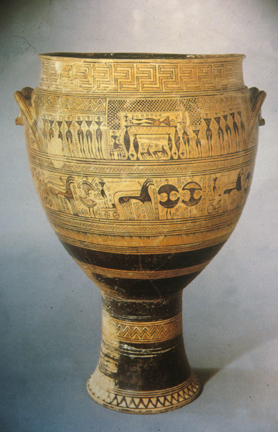This is probably the most famous example of Greek geometric ware, and is called the Dipylon Vase. It was found just outside Athens in a cemetery, whose entrance was flanked by two large pylons, thus its name. Many of the largest and finest of the Greek funerary vases have been found there. This large footed krater stands 42.4 inches in height and was wheel thrown in sections and assembled. At the top is a frieze with a variation on the meander called the 'stepped meander.' Below that is the burial procession. Here we see another burial scene, but this one is more detailed and elaborate and this will be discussed in in the next image, which is a detail of this part of the krater. Below the burial scence is a procession of chariots, horses and warriors. Individual warriors are reduced to highly stylized and geometric figures. At attempt is made to indicate perspective, by drawing three horses pulling each chariot. The three horses are painted one behind the next, but oddly, all 12 legs appear in one plane.

Dipylon Vase, Footed Krater, Earthenware
from Athens, Greece, 800-700 BCE


